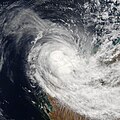Ficheiro:Tropical Cyclone Hubert 2006.jpg

Dimensões desta antevisão: 600 × 600 píxeis. Outras resoluções: 240 × 240 píxeis | 480 × 480 píxeis | 768 × 768 píxeis | 1 024 × 1 024 píxeis | 2 048 × 2 048 píxeis | 5 600 × 5 600 píxeis.
Imagem numa resolução maior (5 600 × 5 600 píxeis, tamanho: 3,6 MB, tipo MIME: image/jpeg)
Histórico do ficheiro
Clique uma data e hora para ver o ficheiro tal como ele se encontrava nessa altura.
| Data e hora | Miniatura | Dimensões | Utilizador | Comentário | |
|---|---|---|---|---|---|
| atual | 03h00min de 28 de agosto de 2006 |  | 5 600 × 5 600 (3,6 MB) | Good kitty | == Summary == {{Information |Description=Tropical Cyclone Hubert formed off the northwestern coast of Australia on April 5, 2006. Cyclones form in this area from December through April each year. In April, the start of the Asian Monsoon season gradually s |
Utilização local do ficheiro
A seguinte página usa este ficheiro:
Utilização global do ficheiro
As seguintes wikis usam este ficheiro:
- en.wikipedia.org
- zh.wikipedia.org


